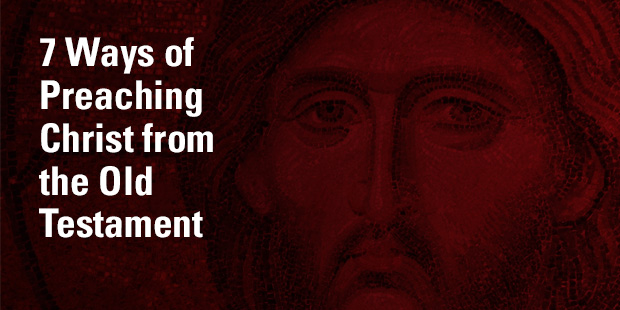
7 Ways of Preaching Christ from the Old Testament
No pastor wants his preaching to be considered “Christ-less” or something other than “Christ-centered.” Still, it is sometimes difficult to understand what exactly is meant by this kind of terminology. Likewise, no pastor wants to “read into” the text something that is not there.
In the initial chapter of his book, Preaching Christ from Genesis, Sidney Griedanus lays out seven ways that a preacher can legitimately preach Christ from the Old Testament. I’ve adapted the examples for each category in order to keep the focus on how there are multiple ways to preach Christ from an Old Testament account (such as Noah).
1. Redemptive-Historical Progression
The redemptive-historical road to Christ is the “broadest and foundational path from an Old Testament text to Jesus Christ” (3). It takes into consideration the history of redemption which begins with the opening chapters of Genesis and culminates in the vision of a restored paradise in Revelation. This journey from creation to new creation takes us down a path of redemptive history in God’s acts in Israel, through Christ, and then through the church. We take into consideration the place we are in the biblical storyline and then look forward to the climax of Christ’s death and resurrection.
An example would be the story of Noah. More than a simple story of warning against judgment, it is also a continuation of the Genesis plotline, where the seed of the woman must avenge the heel of the serpent. God’s preservation of Noah is the way He keeps His promises, and we anticipate the coming of the Seed – Jesus Christ in His first coming and then His second.
2. Promise-Fulfillment
The “promise-fulfillment” motif is a direct road to Christ from an Old Testament text. The New Testament reveals hundreds of passages that promise the coming Messiah. A preacher who utilizes this approach will take a direct road from the Old Testament promise to the New Testament’s fulfillment.
An example is Genesis 3:15, where God promises that one of Eve’s offspring will crush the head of the serpent. Another example is Isaiah 9:6, where God promises that a virgin will bring forth a son whose name will be called Emmanuel. From the New Testament, we recognize this as being ultimately fulfilled in Christ.
3. Typology
Another way of preaching Christ from the Old Testament is through the careful use of typology, seeing Old Testament events, persons, or institutions as foreshadowing Jesus Christ and His redemptive work.
For example, one finds parallels with the story of Noah. Here, we have a righteous man whose family is saved due to his standing with God. In a similar manner, Jesus Christ is the righteous One whose family is saved due to His obedience.
One must take care to not flatten the Old Testament stories that foreshadow Christ by making all details align. But there are indeed hints and foretastes of Christ in the Old Testament, and a wise preacher will make use of them in his preaching. (Here are some examples of how famous Southern Baptist pastor W. A. Criswell and others have done this with the story of Joseph.)
4. Analogy
Another road to Christ from the Old Testament is by analogy. According to Griedanus, “analogy exposes parallels between what God taught Israel and what Christ teaches the church; what God promised Israel and what Christ promises the church; what God demanded of Israel (the law) and what Christ demands of his church” (5).
This approach uses God’s interactions in the Old Testament as a picture that has further application for us today. Jesus used this method when He told the story of Noah as an analogy (Matthew 24:37-41), urging people to repent and thereby escape the coming judgment.
5. Longitudinal Themes
A fifth road to Christ from the Old Testament is similar to the “redemptive-historical” method, but it focuses mainly on the development of theological ideas. These are “longitudinal themes” because they can be traced throughout the biblical storyline, and they develop over time as they culminate in Christ.
Examples of these themes would be God’s kingdom (brought ultimately by Jesus Christ the King), God’s presence (foreshadowed in the Temple but fulfilled in Christ’s incarnation), and God’s judgment (seen in God’s actions against sin, but also His willingness to bring salvation through judgment).
Returning to the story of Noah, we can trace the theme of God’s judgment, understanding that the judgment that falls on the wicked (the flood) is the means of salvation for Noah and his family (1 Peter 3:21). This theme is most clearly seen in the cross, when salvation comes to us through the judgment of God that falls upon Christ.
6. New Testament references
Another road to Christ is found in New Testament references or allusions from the Old Testament. Most often, these references can be used as further evidence of the other ways of pointing to Christ.
Going back to the story of Noah, we could see an allusion to Noah’s faith as referenced in Hebrews 11:7. This reference gives us insight into the nature of true faith in the face of judgment, reminding us of the faith we are to have in Christ for salvation.
7. Contrast
The last road in Griedanus’ taxonomy of ways to preach Christ from the Old Testament is the way of contrast. There are aspects of biblical teaching that are quite different today as a result of Christ’s coming. Griedanus uses the example of circumcision. In the Old Testament, circumcision was required of every adult male. In the New Testament, baptism has become the sign of covenant membership. What is now required is “circumcision of the heart” which is brought about through Christ’s death and resurrection and the indwelling of the Holy Spirit.

Tags: Preaching, Scripture, Trevin Wax, Worship












